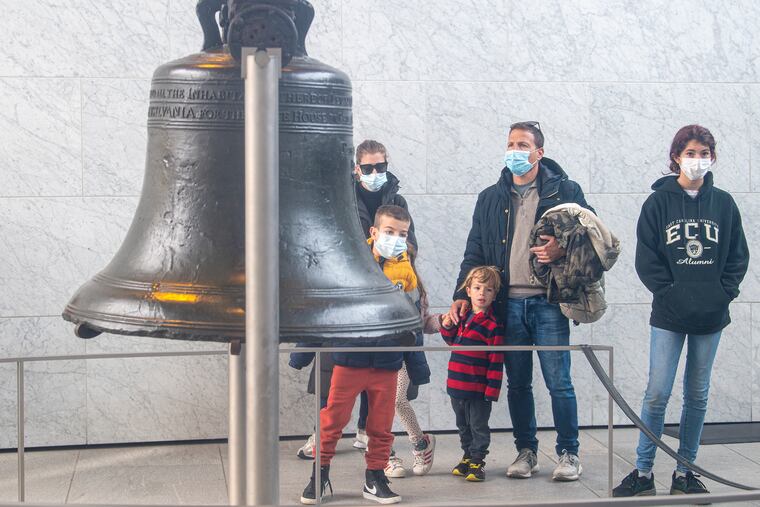So far, BA.2 is proving to be mild in hospitals, despite uptick in cases
Patients who are being hospitalized are less commonly requiring intensive care, some hospitals said.

Two months ago, Geisinger Health was treating 400 COVID-19 patients across its nine Pennsylvania hospitals. After a swift decline following the omicron surge, that number was around 30 in recent days.
“The bad news is that we’ve definitely plateaued,” said chief medical officer Gerald Maloney. The good news: “We’re cautiously optimistic that this time around, if there is an uptick in cases, that many of the cases will not be severe enough to get people into the hospitals and into the ICUs.”
Several weeks into the rise of the BA.2 subvariant, public health predictions that it would not cause a surge in severe illness and hospitalizations seem to be holding true in Pennsylvania, despite upticks in case numbers. Experts have hoped that the level of population immunity after the omicron surge — with most people likely having some protection from a recent infection, vaccination, or both — would head off a more devastating surge.
» READ MORE: As BA.2 spreads, Pa. and N.J. COVID cases are rising again
“I wouldn’t be surprised in the next week or so if the numbers jump a little bit,” Jonathan Stallkamp, chief medical officer for Main Line Health, said Wednesday. But “we aren’t suspecting [there will be] a large increase in hospitalizations, given the fact that people are vaccinated [and] a lot of people have had COVID before,” many during the omicron surge.
Coronavirus case counts have increased nationwide in recent weeks, with the Northeast seeing one of the biggest rises. Over the past two weeks, average daily case counts had increased 88% in Pennsylvania — surpassing 1,000 more than a week ago and continuing to rise since — and 26% in New Jersey as of Monday, though the total number of reported cases remains at relatively low levels.
Hospitalizations had increased by 14% in Pennsylvania and 19% in New Jersey in the same time period, according to New York Times data. In Philadelphia, all eyes were on the numbers last week as health officials cited declining hospitalization and case rates as one reason they abruptly dropped the city’s newly reinstated mask mandate. At the same time, the number of people hospitalized in the city rose by a handful from Thursday to Friday.
» READ MORE: Philly abandoning COVID-19 response levels that led to the city’s mask mandate
So far, several hospital administrators across Pennsylvania and New Jersey say the patients being hospitalized are often not as severely ill as in previous waves, with fewer requiring intensive care or the use of a ventilator.
The University of Pittsburgh Medical Center system had 57 people across its locations hospitalized with an active infection on Wednesday, along with about 200 longer-term COVID-19 patients who were still hospitalized but no longer infectious. Only five of the 57 patients were in an ICU.
“Those numbers are much lower than the peak of the omicron surge, and they’re a little bit above what we had seen at the very lowest numbers about two weeks ago,” said UPMC chief medical officer Donald Yealy. “While we’ve seen more activity in our hospitals because of the new variant, the BA.2 variant … it has not translated into the same level of illness burden that we have seen before.”
» READ MORE: Moderna announces step toward updating COVID-19 shots for the fall
The hospitalization lull is giving hospitals time to catch up on other patient care, such as nonurgent procedures, and is giving staff a reprieve from the winter’s extreme intensity. Across the Geisinger system, for instance, there are fewer emergency department visits and fewer inpatients, and delays for ambulances and emergency services are no longer a problem.
Staffing issues caused by the pandemic, however, including nursing vacancies, still pose a long-term problem, officials said.
“There are a lot of people who left the workforce,” said Mark C. Knouse, chief of the division of infectious diseases for Lehigh Valley Health Network. “It’s harder to hire now. It’s harder to get people to come back now.”
And staff members who have stayed need a chance to recover that many have yet to get, some leaders said.
“The staffing crisis is still with us,” Maloney said. “The staff is maybe not as stretched as they were two months ago, but probably experiencing the same degree of burnout as they were two months ago.”
Despite the optimism, the hospital officials cautioned that it can be nearly impossible to predict what will happen next in the pandemic. It’s still early in the spread of BA.2 — and other subvariants — and because it is so transmissible, people should exercise caution, particularly if they are at risk for more severe cases, doctors said.
“Hospitalizations have not dramatically increased, but we are not out of the woods yet,” said Martin Topiel, infection control officer at Virtua Health in South Jersey. “It’s certainly disheartening when we read things declaring this virus has passed.”